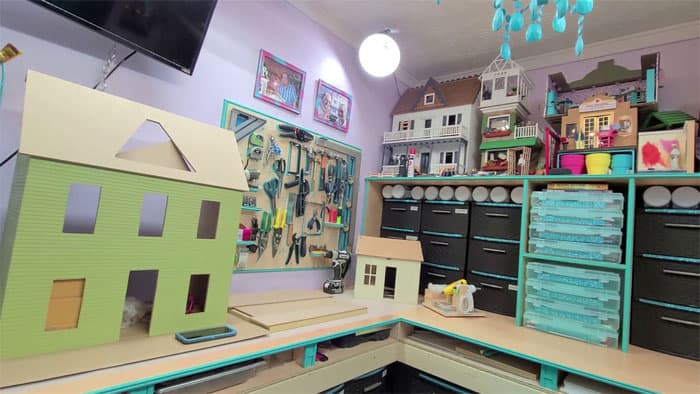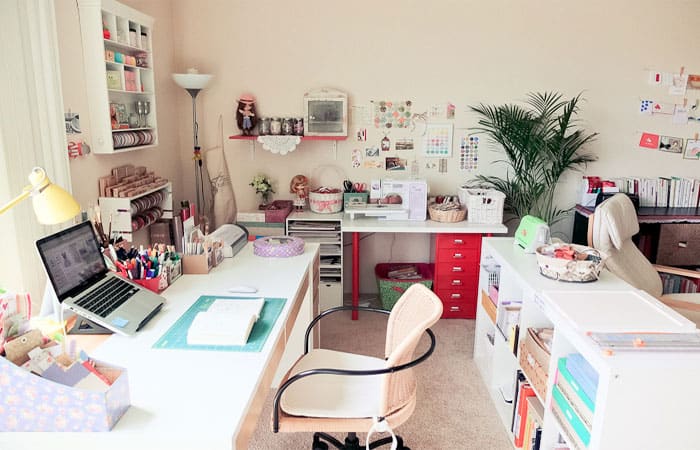Whether you are a serious crafter or just have a knack for DIY projects as a hobby, you need to have a craft room to bring your ideas to life.
This space should inspire you to let your creative juices flow and express your innate artistic flair. It should be comfortable, organised, and most importantly, well lit.
While the first two objectives can be accomplished with a neat furniture arrangement and a run to the nearest IKEA, getting the lighting needs just a tad more work. So, how can I improve the lighting in my craft room, you ask?
Pretty easy once you go through the guide we have put together for you.
Types of Lighting

Before you start, you need to have a good idea of the different ways to illuminate a room. Getting good and natural lighting is not as easy as buying a daylight bulb and hoping everything turns out right.
They must be strong enough to eliminate all shadows and bring out the true colours.
- General Lighting
The general or ambient lighting sets up the tone of your room. It creates a soothing environment for you to relax and let go of all your worldly tension while promoting productivity at the same time.
General lighting is the most ‘natural’ in the room, helping you see everything there is to see, navigate the room, and rummage through your storage boxes. This lighting bounces off the walls and generates an overview of the room.
If you have other light fixtures placed around the room, a general illumination helps in offsetting their brightness and reducing the strain on your eyes. Simply placing a ceiling light fixture would help in evenly casting the diffused light around the room.
You can get this lighting effect with chandeliers, pendants, recessed, or track lighting.
- Task Lighting
As the name suggests, these lightings illuminate your workspace, concentrating on the task you are carrying out. They have a smaller focal point and are brighter than the other lights in your craft room. This creates a contrasting effect, pulling all your attention in that one direction.
With arts and crafts, you must be able to see your hands and whatever you are working on. There are a lot of details that are in play. And there is also the matter of true colors.
Having task lighting stimulates your brain to be alert to the details and reduces the chances of mistakes. It also helps to line your crafts and create high-quality products.
Just remember that the light should be strong and properly diffused to not throw around any strange shadows. You must also avoid harsh lights that may strain your eyes.
Task light should be positioned above your workstation so that the casted light directly falls on what you are doing. Art lamps are an amazing option for localised lighting.
They are easily available in stores and are great if you are running tight on a budget. We also suggest using LEDs because they are long-lasting, highly energy-efficient, and radiate less heat.
Other sources of task lightings are tape and track lighting, portable or swing lamps, undercabinet and pendant lights, etc.
An important thing to remember while setting up task lighting is that they must have their individual controlling switch.
- Accent Lighting
Accent lighting is just as important as the other two when setting up a crafts room. It is the final layer that any room needs. This lighting adds a ‘special touch’ to your studio, creating dramatic effects and combating any harsh brightness.
Also, accent lights draw attention to certain parts of the room and thus create a sophisticated atmosphere. You can use them to highlight your artworks or bring attention to any display section you might have.
This is very efficient if you are running a small business or commercial page and need to showcase your projects now and then.
By strategically placing table lamps or floor lamps, you can illuminate dark corners & areas and make the room feel bigger and airier. And if you don’t have enough floor space, you can instead opt for track or recessed lighting. Wall lights can be used along the perimeters of the room as well.
- Natural Lighting
We could not help but include this here. How can we not? We love the ambience created by artificial lighting when done right. But when it comes to natural lighting, everything else falls to shame.
Natural light leads to greater productivity and efficiency. It also has many benefits, such as reduced eye strain, fewer headaches and drowsiness, better mood and output quality. And the best part is that it is cheap, simple, and readily available.
You can place your workstation by the window to let a lot of sunlight in during the day. This would also decrease your power bills and energy consumption.
However, it could result in glares and hot spots, along with unwanted shadows. Use frosted glasses, soft boxes, or other diffuser surfaces to cast the light throughout the room.
How to Control the Lighting in a Crafts Room

Now that you have decided on the lighting arrangement for your room, you must think about how you’ll control them. Each fixture should have a separate switch to individually control them.
You could place the switches for general lighting right as you walk into the room. Place the ones for task lighting near your desk.
Now, you always have the option to control the brightness from your smartphones and tablets as well. You’ll be able to adjust the intensity according to your preference.
However, you should keep track of the lighting & electrical outlets and not use too many at the same time. Too much power consumption can make the breaker to blow.
Conclusion
A craft room in the house is nothing short of a haven. From the moment you walk into that room, you get cut off from the real world. And the problems that have been gnawing at you all day seem trivial for a few precious hours.
So, build that dream workspace of your own. Don’t let questions like how can I improve the lighting in my craft room deter you from going for it.

